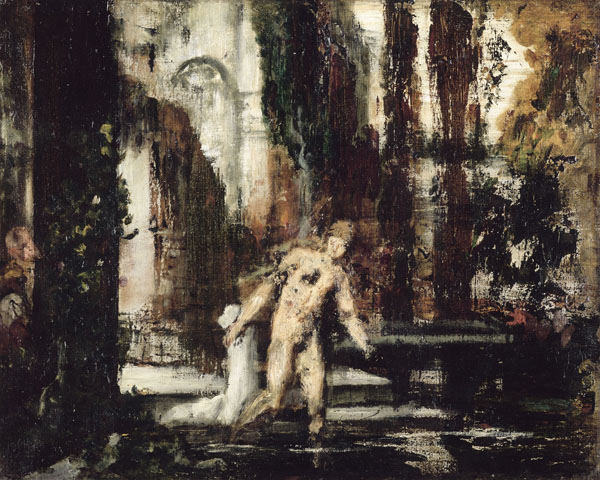Fr : version française / En: english version
mheu, Historical Museum of the Urban Environment
Susanna
Gustave Moreau

19th century
oil on canvas
33cm x 40cm
Paris, Musée Gustave Moreau
© RMN / René-Gabriel Ojéda
View this work in the exhibition Bathing
The work
In this sketch, Susanna is stepping into the bath and her position is reminiscent of Moreau's female study for Delilah. The two elders are hidden behind a wall. In another drawing, we see the same figures approaching Susanna who is defended by Daniel in the final judgment. No more expressions of lust in Moreau. It is the second half of the 19th century and bourgeois order prevails. Sensuality is banned. The twinkle in the eye of the viewers of centuries past has faded. Moreau himself called another of his paintings Chaste Susanna. "Et les enfants de chœur / se masturbaient tout tristes", sang Brassens.
The artist
Gustave Moreau is an unclassifiable painter. Born in Paris in 1826, the son of an architect, he had poor health and entered the Ecole Royale des Beaux-Arts only in 1846. He failed twice at the Prix de Rome, was influenced by Théodore Chasseriau, the neoclassical painter who was a pupil of Ingres, and traveled several times to Italy where he copied the masters. This background was to lend his art a slightly academic, slightly Carpaccio-style Italian, slightly romantic, symbolist, religious touch, unusual in its desire to escape from reality. Moreau exhibited several times in the Salons with mixed results. Napoleon III liked his art, as a result of which he was awarded medals and a Légion d'Honneur and, in 1888, was elected to the Academie des Beaux-Arts. From 1892 until his death in 1898, he taught at the Ecole des Beaux-Arts where his pupils included Matisse, Rouault, Manguin and Marquet.